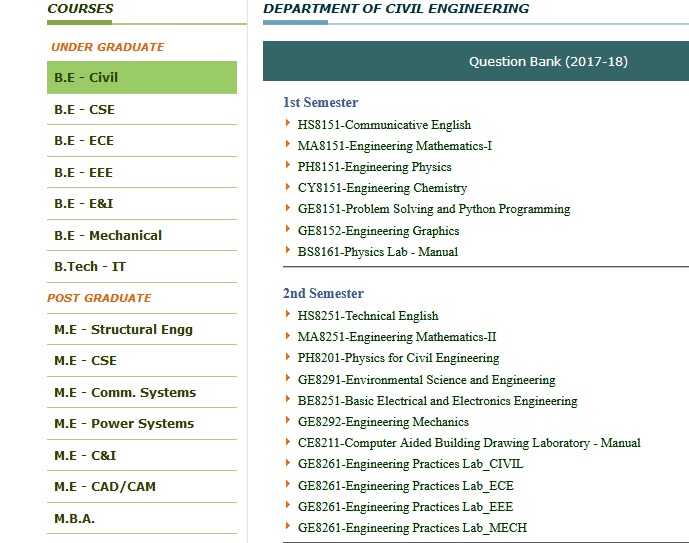CE2303 RAHE Question Bank : valliammai.co.in
Name of the College : Valliammai Engineering College
Subject : RAHE
Website : valliammai.co.in
Document Type : Question Bank
Download Model/Sample Question Paper :
QUESTION BANK : https://www.pdfquestion.in/uploads/valliammai.co.in/468-CE2303-RAHE.pdf
Valliammai RAHE Question Paper
CE2303-RAHE
QUESTION BANK
UNIT I
Part A
1. Why is railway track termed as permanent way?
2. What is coning of wheels? What is its purpose?
3. Define Creep of rail and mention its causes.
Related : Valliammai Engineering College ED7004 Design of Hydraulic & Pneumatic Systems M.E Question Bank : www.pdfquestion.in/2848.html
4. Distinguish between double headed and bull headed rails.
5. Enumerate the factors affecting the choice of railway gauge.
6. Mention the use of remote sensing in route alignment.
7. State advantages of ballast less track.
8. Define obligatory points.
9. What is Cant Gradient?

10. State any four ideal requirements of a permanent way.
11. Enumerate any two merits of EDM with respect to any one corresponding conventional instruments.
12. A B.G. railway track is designed for a ruling gradient of 1in 200 on a curve of 2°. Find the grade compensation.
13. Differentiate L.R.T. and M.R.T.S.
14. Define sleeper density.
15. What is a pandrol clip?
16. Draw a sketch of a railway track and its components.
17. Define ‘Fish Plate’. Why is it named so?
18. Mention the types of rail joints.
19. Define transition curve and list its types.
20. What are the basic requirements of a ideal rail joint.
Part B
1. A. Explain in detail the importance of Indian Railways in the National Development in terms of economic, social, spatial and political contributions.
B. Draw the cross section of a double track permanent way in embankment and indicate the components.
2. A. Briefly explain the modern methods of surveys for track alignment.
B. What is the necessity of geometric design of a railway track? Enumerate the significant features of design of a railway track.
3. A. What is a sleeper density? What sleeper density is adopted in Indian Railways? Why sleepers are not uniformly spaced throughout the length of rail?
B. What are the requirements of an ideal joint? Explain any two joints used in Indian Railways with neat sketches.
4. A. Explain the four stages of engineering surveys to decide railway alignment.
B. What are the different types of gradients in railways? Discuss the factors governing the gradients.
5. A. Derive an expression to establish relationship among gauge, speed, radius of curvature and super elevation.
B. A 8° curve track diverges from a main curve of 5° in an opposite direction in the layout of a B.G. yard. Calculate the super elevation and the speed on the branch line, if the maximum speed permitted on the main line is 45 Km/hr.
6. A. Compare and contrast the different types of sleepers used in railways.
B. The average speed on a B.G. 3° curve is 75 Km/hr. Compute the equilibrium super elevation and the maximum permissible speed allowing for a cant deficiency of 75mm.
7. Write short notes on the following. (a) Ballast less Track (b) Negative super elevation. (c) Widening of gauge (d) Grade Compensation
8. A. A BG curved railway track has a 4° curvature and 12cm cant. Maximum Permissible speed on the curve is 85Km/hr. Determine the length of the transition curve.
B. A vehicle moving on a BG track has a wheel base of 4.724m. Diameter of the wheel is 1524mm. Flanges project 32mm below top of the rail. Radius of curvature is 168m. Determine the extra width of gauge required.
9. Draw a neat dimensional sketch of permanent way cross section and explain the functions of various components.
10. A. Describe the preliminary survey for the alignment of a railway line. Enumerate the data to be collected.
B. Briefly explain about the use of Remote Sensing and GIS for track alignment.
Unit II
Part A
1. What is meant by Turnout ? Why is it required?
2. What is Track Circuiting? State its purpose.
3. Define theoretical nose of crossing.
4. What is a semaphore signal?
5. Define throw of switch.
6. What is a junction station?
7. What are track resistances?
8. Define yard and state its types.
9. Briefly explain the different aspects of semaphore signal
10. What is a trap indicator?
11. Write short notes on audible signal.
12. Explain briefly Automatic Warning system.
13. Differentiate space interval system and time interval system.
14. List out the various modern signaling installations.
15. Define sighting board. Mention its purpose with neat sketch.
16. Differentiate contrary flexure and similar flexure with neat sketch.
17. Draw a neat sketch of scissor crossover.
18. Distinguish between co-acting and repeated signal.
19. Define routing signal.
20. Differentiate mechanical signaling system and electrical signaling system.
Part B
1. What are points and crossings? Draw a neat sketch of a right hand turnout and indicate the components. State its working principle.
2. a) How are signals classified? Explain how the locational signals are used to guide the trains.
b) Explain with neat sketch a diamond crossing.
3. Explain about Marshalling yard with a neat sketch.
4. a) Discuss the importance of track drainage. How is it achieved?
b) Explain the centralized train control system.
5. Describe the operations involved in plate laying by telescopic method.
6. a) What is directed track maintenance of high speed tracks? Discuss the suitability of this method under Indian conditions.
b) Explain automatic block system of train control.
7. a) What are the functions of railway station? Explain briefly the various requirements of a railway station at an unimportant city.
b) Why is relaying of track required? Describe the standard method of relaying a track?
8. Write short notes on a) level crossing b) Interlocking c) Rolling stock d) Wayside station.
9. Mention the objectives of signaling. How are signals classified? Mention the functions of each signal.
10. Explain modern methods and materials used for construction of railway tracks.